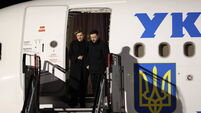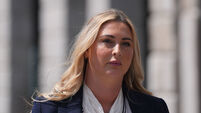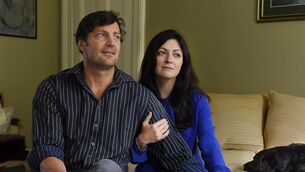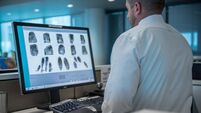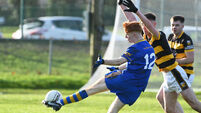Meet the Cork doctor who survived an atomic bomb

‘There then followed a blue flash accompanied by a very bright magnesium-type flare ... Then came a frighteningly loud but rather flat explosion which was followed by a blast of hot air … All this was followed by eerie silence.’
That’s how Aidan MacCarthy had described the dropping of the atomic bomb, just over a mile away from his makeshift shelter in the Mitsubishi POW camp.
A Doctor’s Sword, written by Bob Jackson, will be launched in the aptly named MacCarthy’s Bar in the doctor’s hometown of Castletownbere, Co Cork.
The launch is co-hosted by Beara Historical Society as part of Heritage Week 2016.
Bob first heard of Dr MacCarthy more than 16 years ago while working in a bar in Cork City, when one of the regular customers who had been in the RAF, retold a well-known story locally of a doctor in West Cork with a connection to the atomic bomb in Nagasaki.
Intrigued, Jackson travelled to MacCarthy’s Bar in Castletownbere where he met the GP’s daughter, Adrienne.
He was stunned to learn that not only had Dr MacCarthy survived the atomic bomb but Kusuno, the Japanese commander of the camp where he had been held prisoner, had gifted his family’s ancestral samurai sword to him.

“Aidan MacCarthy was one of a handful of people who survived the two events that mark the beginning and end of the Second World War,” said Jackson, a lecturer in creative media at the Institute of Technology, Tralee.
“He was evacuated from the beaches of Dunkirk after three days of relentless attacks in May 1940, and he was trembling in a makeshift bomb shelter in the centre of Nagasaki when the atomic bomb destroyed the city on 9 August 1945,”
In the intervening years, Dr MacCarthy had survived burning planes, sinking ships, jungle warfare, starvation, disease, captivity, and slave labour in Japanese POW camps.
“I read Aidan’s memoir, which is a fascinating and engrossing account of his story but because of his genuine, self-effacing, modesty it’s often short on detail. Yet his character comes through more in what he does not say,” said Jackson.
“I wasn’t surprised that, in the devastating aftermath of the atomic bomb, he was the first non-Japanese doctor to assist civilians.
“I wanted to know more about that samurai sword — especially since there was a possibility that the ashes of the officer’s ancestors were embedded in the handle.
“After Aidan’s widow, Kathleen, mentioned there was a photo of the Japanese officer somewhere in their belongings, I persuaded his family to look for it.”

After years of searching, another daughter, Nicola, found the photograph and travelled with Jackson to find the family of the Japanese commander. In a moving encounter detailed in A Doctor’s Sword and in the critically acclaimed documentary of the same name, they met the man’s descendants at a cemetery in Kyushu Island, including his grandson, who credits his existence to Dr MacCarthy’s act of selflessness in saving his grandfather’s life.
Meanwhile, a new medical facility at RAF Honington, where Dr MacCarthy served during the war, will be named in his honour in a ceremony which will take place next February.
A Doctor’s Sword – How an Irish Doctor Survived War, Captivity and the Atomic Bomb is published in hardback by The Collins Press, priced €19.99. Also available online from www.collinspress.ie
Story of his life in brief

Aidan MacCarthy graduated in medicine from University College Cork in 1938 and travelled to London in search of adventure. He and his friends couldn’t decide between joining the Royal Air Force or the navy so they asked a hostess in a West End bar to toss a coin. They joined the RAF the next day — September 4, 1939, the day after the Second World War was declared.
Dr MacCarthy was awarded the George Medal, the highest award for bravery for non-combat personnel in the British armed forces when he rescued the crew of a bomber that crash-landed at an RAF base in England in 1941.
When he was a student, he saved the lives of his mother, aunt, and cousins when their pleasure boat caught fire in Castletownbere harbour. He tied a rope around his waist and swam to the shore, dragging the burning boat behind him.
He spent the final year of the Second World War working as a slave for the Mitsubishi Corporation. After the war, he was never bitter towards the Japanese but refused to allow a Mitsubishi car in his driveway.
The Mitsubishi Steel & Arms Works, the Nagasaki factory, where he was imprisoned and where he sought refuge from the atomic bomb, was in fact the target of the bomb on August 9, 1945.
He put his medical training to good use in the camp while treating his fellow prisoners, including making a protein-rich maggot soup for those who were ill, smuggling yeast in balls of rice to other camps, and treating eye infections with shaving cream.
Dr MacCarthy was the first non-Japanese doctor to assist civilians in the aftermath of the atomic bomb attack on Nagasaki.
On August 15, 1945, the day the Japanese surrendered, he was gifted an ancestral Japanese sword by his camp commandant, whose life he saved from POWs intent on revenge.
He was one of the few people who survived the two events which bookend the Second World War — Dunkirk and Nagasaki.
The Japanese ship on which he was being transported to Nagasaki was sunk by an American submarine. Out of the 1,000 POWs on the ship, just 35 survived.
Before the war, he had weighed 14 stone. When he returned home at the end of the war, following years of starvation and malnutrition, his body weight had halved to just seven stone.




